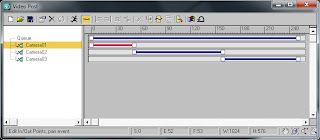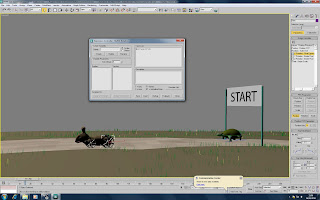Using a script for the animation some volunteers recorded the narration and voices. A shotgun fire was located for the race start, and also some general sounds of gravel been walked over.
These sounds were attached to the appropriate parts of the story within adobe premiere pro and the complete animation then exported into a video file. On playback of the whole animation I noticed that the sounds overpowered the visual, as such I opened up the sound files into adobe soundbooth and adjusted the amplitude for them. The edited files were then imported back into adobe premiere pro and used to replace the sound files there.
Thursday, 28 April 2011
Scenes
Using the storyboard as a guideline I devised several scenes by which to tell the story. The story basically starts with the hare boasting how fast he was to the tortoise, leading the tortoise to challenge him to a race. It then goes on to see the race start with the hare speeding off into the distance and the tortoise moving very slowly. The hare, seeing how far ahead he is moves off the path to have a rest, but then falls asleep. The tortoise carries on slowly and gets close to the finishing line. The hare then wakes up and looks up with surprise to see the tortoise near the end. Quickly the hare speeds off back down the path and is just about to pass the tortoise and go through the finishing line when he strikes a small rock on the ground and his front wheel falls off. This leaves the tortoise to walk slowly on through the finishing line and win the race.
Monday, 16 August 2010
Video post?
In one scene I had three camera changes. Instead of rendering this as three seperate scenes I opted to use the video post to set up when each camera should take over.

This process seeemed easy enough until I chose to execute the sequence to render the scene. The scene apparently rendered, but I do not know to where it would have been saved as there were no options as to which directory to save the file. As such I ended up rendering each camera view individually then importing them into adobe premiere pro where they were cut and spliced together in the proper order
Rendering problems
When attempting to render static frames from some of the scenes the computers within the lab kept becoming non-responsive. To try and overcome this problem I used backburner to assign the job to several computers at once. However the problem encountered here was that the networked home drive kept going offline.
To use backburner one machine was set up as a manager and then others were connected as servers (including the manager machine itself) The jobs allocated and each server's progress was then viewed on the manager machine using the backburner monitor. This meant having to import 200-300 individual jpeg frames into adobe premiere pro and editing them to work as a whole by placing them on the timeline, selecting all, decreasing speed/duration to lowest amount possible and using ripple edit feature to apply this to all frames.
Other scenes were rendered as .avi files in stages to speed up the rendering time e.g 1 computer was set to render frames 0-50, another was set to render 51-100, yet another to do 101-50 and so on.
To use backburner one machine was set up as a manager and then others were connected as servers (including the manager machine itself) The jobs allocated and each server's progress was then viewed on the manager machine using the backburner monitor. This meant having to import 200-300 individual jpeg frames into adobe premiere pro and editing them to work as a whole by placing them on the timeline, selecting all, decreasing speed/duration to lowest amount possible and using ripple edit feature to apply this to all frames.
Other scenes were rendered as .avi files in stages to speed up the rendering time e.g 1 computer was set to render frames 0-50, another was set to render 51-100, yet another to do 101-50 and so on.
The tortoise moves
I used the bones system on the tortoise to make it move. This proved harder than it looked and actually took several tries before I got it to be anywhere near passable. Inverse kinetics were also set up to enable controlled movement of the bones, but even so found this to be a rather fiddly process despite editing the envelopes around each bone. I think the bones system is one of those things that takes time getting use to, maybe with lots of practise I will become proficient at it.
Wheel rotation on hare
Use of the path constraint to make the hare move meant that the wheels were static. To make them rotate each wheel had a float expression attached. Each wheel was selected and in the motion panel the 'x' rotation was selected >assign controller >float expression.

To ensure that the wheels stayed attached to the main body of the hare I used the schematic view to connect all the parts together


To ensure that the wheels stayed attached to the main body of the hare I used the schematic view to connect all the parts together

1, 2, 3 go!
At the start of the race I used the path constraint on the hare to enable it to move off the starting line faster than the tortoise.
Subscribe to:
Comments (Atom)

